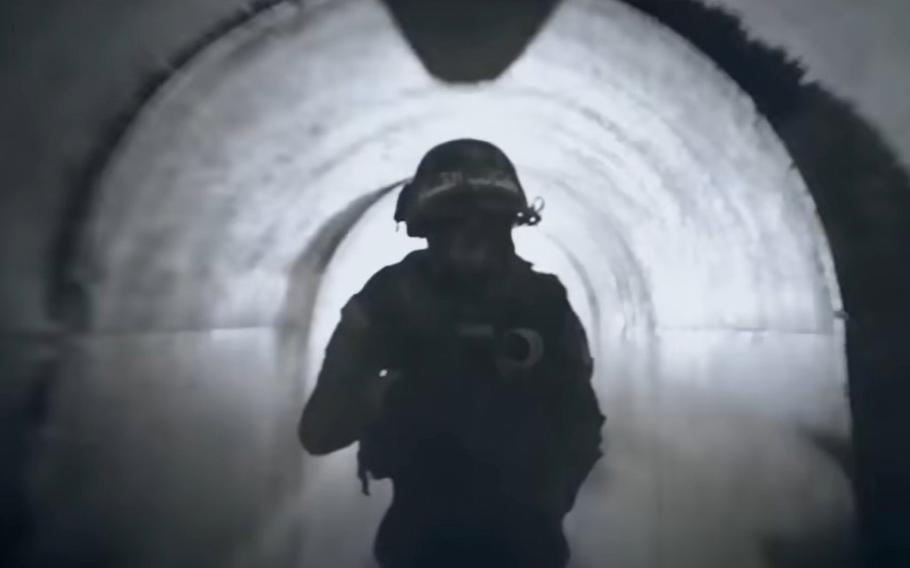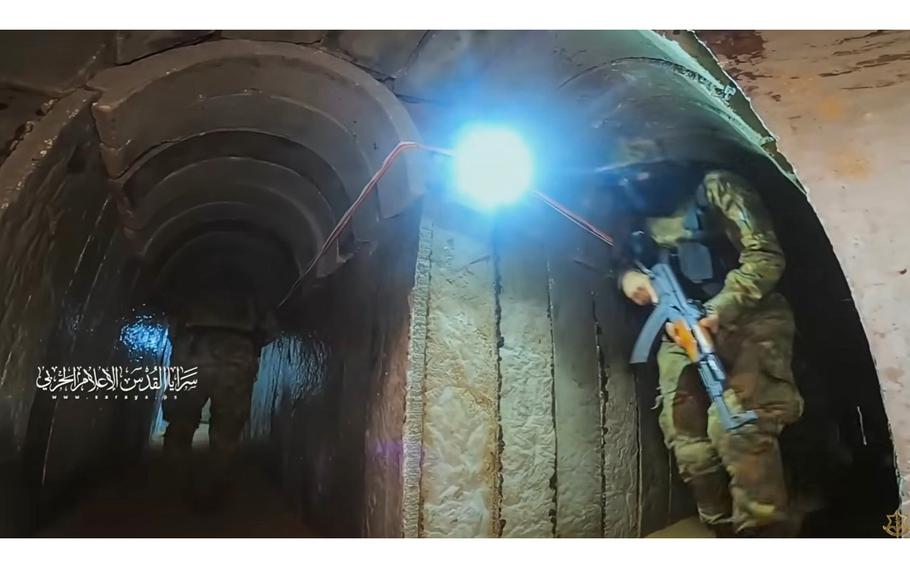Middle East
How Gaza’s tunnel network leaves Israel facing ‘three-dimensional’ war
The Washington Post November 3, 2023

A video screen grab shows a militant navigating through a tunnel in Gaza. (YouTube/Israel Defense Forces/Hamas and Islamic Jihad videos)
JERUSALEM — So threatening is the vast subterranean maze dug by Hamas that Israelis in past battles dubbed the structures “terror tunnels.” This underworld of passageways, arms caches and escape routes beneath Gaza may prove even more terrifying now.
As Israel’s ground troops drive to encircle Gaza City, the two sides could find themselves fighting a “three-dimensional” urban war - with combatants firing from the roof tops of shattered buildings, from the rubble-strewn streets and from the underground warrens, say military analysts.
All this could be happening in neighborhoods still filled with civilians - and children.
Israeli officials estimate there are 1,300 tunnels, spanning 300 miles across the Gaza Strip, which itself is just 25 miles long. The military describes the network as one of the most elaborate underground webs in the world. It says there are underground bunkers beneath Gaza hospitals. Palestinian doctors have denied this.
Israeli military protocol generally prohibits regular ground troops from entering tunnels, as the chances of being killed or captured is too high. Israelis have seen their soldiers grabbed and dragged into tunnels, so the likely strategy will be to attempt to destroy them from a distance.
In an interview last week with The Washington Post, senior Hamas leader Ali Baraka, based in Beirut, said that “the fighters are underground, waiting for the battle.” He claimed that there are 40,000 operatives in the Izzedine al-Qassam Brigades, Hamas’s military arm, and 20,000 in other factions. “They can’t handle 60,000,” he said, calling out the Israeli military.
The Hamas passageways, dug with hand tools over decades, are reinforced with precast concrete and have tramways for hand trolleys, electric lighting, communication nodes and ventilation fans.
Most are narrow, from elbow to elbow, and barely tall enough for a short man. But some are wide enough for small vehicles. Past battles suggest that many of the tunnels could be booby-trapped.
There are so many tunnels that the spokesman for the Israel Defense Forces, Rear Adm. Daniel Hagari, has taken to calling the underground system the “Gaza Metro.”
These tunnels could allow Hamas fighters to quickly redeploy over significant distances - not just from street to street - and to resupply, rearm, evacuate their wounded and escape. The Hamas leadership has stressed that the tunnels are not for civilian use as air-raid shelters. The network, Hamas insists, is for fighters only.
Israeli forces have already engaged in gun battles with Hamas militants who appeared from the tunnels. The air force has also pounded suspected tunnel sites while targeting Hamas commanders, said the Israel Defense Forces, or IDF.
The intense bombing of the Jabalya refugee camp in recent days left huge craters, which Marc Garlasco, a military adviser at the Dutch organization PAX for Peace and former U.N. war crimes investigator, said were probably caused by Joint Direct Attack Munitions, or JDAM bombs, using a delayed fuse.
“When a 2,000-pound bomb hits the ground, the earth turns to liquid,” Garlasco wrote in a message to The Post. “It’s like an earthquake.” Hundreds of civilians living in the area were killed and wounded in those attacks.
In 2014, in the last major ground offensive into Gaza, which lasted 50 days, the Israeli military reported that it “neutralized” 32 tunnels, 14 of which crossed into Israel.
Those “attack” or “offensive” tunnels, dug from the Gaza side and toward Israeli territory, were designed by Hamas to launch strikes at Israeli military bases and farming villages along the Gaza border. A major aim of the Israelis in the 2014 war was to destroy tunnels.
As the world has seen, during the Oct. 7 incursion into Israel, Hamas did not rely on tunnels to breach the country’s security perimeter. Militants crossed above ground through the Israeli walls, berms and fence lines with relative ease, as shown on body cameras worn by Hamas operatives.
In this invasion, Israel has declared that its goal is to destroy Hamas as a governing and military force in Gaza, while also rescuing the 240 hostages taken by Hamas and other militants. The whereabouts of the hostages are unclear, but the IDF believes that many may be held in the tunnels.
One of those taken captive, Yocheved Lifshitz, the 83-year-old released last week by Hamas, told a crush of reporters in Tel Aviv that Palestinian gunmen had taken her on the back of a motorcycle “until we reached the tunnels.”
“There we walked for kilometers underground in the damp soil,” she said, adding that the tunnel network was “like a spiderweb - lots and lots of tunnels.”
“We reached a large chamber where about 25 of us were assembled,” she said. There they were held until her release more than two weeks later.
Joel Roskin, a geologist at Bar-Ilan University, said the layers of sandy silt laid down in Gaza over the past 500,000 years is perfect for shallow tunnels.
“We are not talking stone and rock, and so simple tools can be used to dig, tools you don’t hear from above,” he said.

A video screen grab shows militants navigating through tunnel networks in Gaza. (YouTube/Israel Defense Forces/Hamas and Islamic Jihad videos)
The digging of water wells for agriculture is an ancient practice in Gaza, Roskin said, and that know-how was deployed to dig tunnels at Rafah between Gaza and Egypt in the 1980s to enable smuggling, a business that flourished under Hamas after Israel left the Gaza Strip in 2005.
Those smuggling tunnels were big enough to bring in fertilizer, livestock, electronics, cement and even disassembled Mercedes-Benz sedans - as well as weaponry for Hamas.
Later, Hamas went on a tunnel-digging spree across Gaza. The underground infrastructure is used for command-and-control centers, armories, food and fuel warehouses, weapons caches, and underground factories to manufacture rockets.
Ben Milch helped strike a limited blow against the tunnels in 2014. During that summer, the Iowa-born immigrant to Israel was a commander in the Combat Engineering Corps in Gaza, where his unit destroyed 15 tunnels.
“In 2014, our objective was to destroy the tunnels that were leading into Israel - so we didn’t go very far into the Gaza Strip,” he said, estimating that Israeli troops ventured less than two miles into the territory.
This war could be very different, he said.
In earlier fights, Milch said, the army would use smoke bombs to discover the ventilation shafts of Hamas tunnels, then dig down using armored excavators and bulldozers, and destroy the tunnels with explosive charges.
He remembers dropping smoke bombs into the tunnels and seeing the plumes of not one or two ventilation shafts but “20, 30, 40” over an area the size of a football field. “So it was clearly intertwined and a maze, essentially,” he said.
Kobi Michael, a senior researcher at Israel’s Institute for National Security Studies, said, “We are not going to enter the tunnels themselves; we are not going to fight in the tunnels, 30, 40 meters under the ground.”
“We have, I assume, some creative means and manners that will enable us to destroy these tunnels on the heads of Hamas terrorists that are hiding inside,” Michael said, declining to speculate on the use of classified sensors in the field.
There are IDF special forces that have trained in tunnel fighting. The Israelis have also used robots.
For the Israelis, identifying tunnels relies on gathering intelligence about their locations, as well as sensors and other methods.
Israel has spent a fortune erecting a hard “obstacle wall,” which is a kind of underground shield on Gaza’s periphery. It has deployed ground sensors to listen to the sound of shoveling, find cavities and detect movement. Many of the tools were first developed for the search for oil and gas.
The challenge, say some experts, is that these “geo-phones” may work well in sterile, quiet environments, but less so during a battle with tanks rumbling nearby and ordinance exploding.
Daphné Richemond-Barak, at the International Institute for Counter-Terrorism at Reichman University in Israel, said tunnel warfare has always been challenging, citing Vietnam, Afghanistan, Syria and Iraq.
“But now when you bring this into an urban environment, where civilians might be present, the task becomes almost impossible to overcome,” she said, noting that the overlay of urban and subterranean terrain introduces an “unprecedented level of complexity.”
“It’s exponential, in a way,” she added. “It’s not just worse; it’s exponentially more complicated to fight in this kind of environment.”
Israeli military spokesmen say hundreds of underground targets have been hit in four weeks of bombardment, which officials in Gaza say has claimed thousands of civilian lives.
Military analysts assume that the Israeli attacks have used bunker busters, precision-guided strikes, thermobaric weapons and, potentially, even high-pressure water.
“What we’re likely to see is Israel using a combination of these different methods - and potentially even new ones, depending on the type of subterranean structures, depending on its location within the Gaza Strip, and depending on civilians around the structure, if there are any still there,” said Richemond-Barak.
Sarah Dadouch in Beirut and Miriam Berger in Tel Aviv contributed to this report.